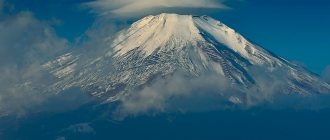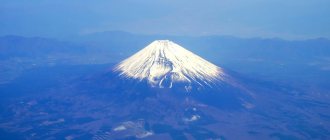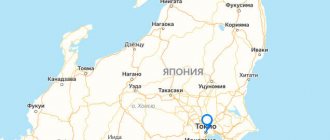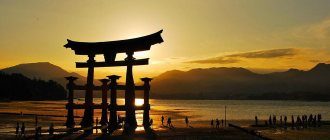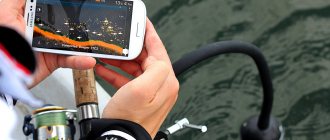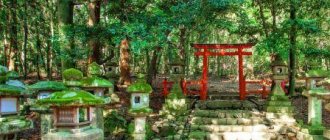Sakurajima is an active stratovolcano and is among the most dangerous in Japan. It is located on the small Osumi Peninsula, on the island of Kyushu, and covers an area of about 77 km². The volcano has three peaks with craters, the highest Kitadake rises above sea level to a height of 1117 m. For many years, Sakurajima has not tired of demonstrating its active activity and periodically sprinkles ashes on nearby cities and villages.
Location: Osumi Peninsula, Japan Height: 1117 m Type: stratovolcano Number of eruptions: unknown, most recent in 2014
Sakurajima: how to get there
From Kagoshima Central Station (鹿児島中央), we took a bus that goes to the terminal station Suizokukan (水族館). Just need to get off at the terminal station Suizokukan (水族館), you can’t go wrong.
Afterwards, we took the ferry to Sakurajima Island (桜島).
The journey takes 15 minutes. Cost 160 yen (about $1.6).
THE BIG THE ONE
Post Views: 3,369
According to volcanodiscovery, on March 13, 2021, another eruption of the Japanese volcano Sakurajima began:
Sakurajima's last major eruption was on December 3, 2020. Since the middle of the last century it has been erupting regularly, and since about 2017 it has been erupting very often, so there is one more active volcano, one less - what's the difference? However, there is actually something very, very serious about this volcano.
November 2020:
UFOs captured over Sakurajima Volcano webcam, Japan. pic.twitter.com/KGcJ0CWhd2
— UFOS-EXPOSED (@UFOS_EXPOSED) November 17, 2020
December 2020:
https://twitter.com/NIBIRU81005406/status/1340023363805306881
January 201:
@Sakurajima Volcan Japón 3: De donde proceden los Rayos, provocan la Explocion del Volcan: #Volcan #volcanfujiteriyaki #volcanes #vocanesdejapon #ovni #ovnis #alien #aliens #ufo #rods #Extraterrestres #Abducción #PollloRivers #drone #alienígenas #abrohilo pic.twitter.com/BqGYGnCMZl
— jaime el pensador (@PensadorJaime) January 26, 2021
@Sakurajima Volcan Japón 5: En la Boca del Volcan veras Ovnis Drons ¿Absorbiendo Electricidad? Se desconoce: #volcán #volcanes #volcanesdejapon #ovni #ovnis #alien #aliens #ufo #rods #Extraterrestres #Abducción #PollloRivers #AbroHilo #alienígenas #drone #PollloRivers #AbroHilo pic.twitter.com/RfxzClpLF0
— jaime el pensador (@PensadorJaime) February 7, 2021
February 2021:
Nothing is known about the nature of these green lights. At one time they thought that these were some kind of experiments by Japanese officials, for example, some kind of laser rangefinders, but there was no confirmation on this matter from geologists. In addition, some green flashes are often seen right inside the ash column. No UAV can operate in such conditions, and they are too bright for a human-made device. Finally, in addition to green rays and a flying wing with lights, there is such a strange phenomenon as green meteorites shooting at the volcano as if at a target:
@Sakurajima Volcan Japón: 3 elementos, Ovni Drone parte superior izquierda, Nube Volcan algo parapadea, cae Meteoro o Que es??: #volcán #volcanes #volcanesdejapon #ovni #ovnis #alien #alienígenas #ufo #rods #Extraterrestres #Abducción # ciencia #insolito #PollloRivers #AbroHilo pic.twitter.com/ggZNTvq7hY
— jaime el pensador (@PensadorJaime) January 22, 2021
All this allows us to think that some “Martians” are watching the volcano more closely than Japanese geologists. At the same time, there are many active volcanoes in the world, only about five are currently erupting in Indonesia. And there are also webcams and mobile phones, but no one notes any particular UFO activity. UFOs, naturally, appear there from time to time, but not with such frequency. Therefore, you need to think that Sakurajima is some kind of very important, trigger volcano. That is, if a serious eruption begins there, then either Japan will begin to sink under water, or it will begin to explode everywhere at once.
However, on March 13, some kind of eruption began - the rituals of the “Martians” did not help. Will this end in another fading or will it develop into something more? It is pointless to make forecasts based on the first hours of the eruption, but if the “Martians” are now running around Sakurajima, it means that it will soon boom with terrible force, so we are monitoring the development of events.
Sakurajima: Dinosaur Park
The dinosaur park is quite interesting!
Look how many different dinosaurs there are! It looks really cool with the Sakurajima volcano in the background
You can climb into the mouth of such a dinosaur, which is exactly what we did.
And you can climb up to the back of the dinosaur right through the belly and slide down, excuse me, out of the ass.
Walking a little further we saw a children's park.
The children rode down such a steep slide. From the top of the hill there is a wonderful view of the city of Kagoshima .
The volcano is visible from the park. We sat on a bench and enjoyed the Sakurajima volcano .
Current activities of Sakurajima
Since 1955, the volcano has been erupting almost constantly. Every year there are thousands of small explosions and ash emissions up to several kilometers high. In 1960, an observatory was built on its slopes specifically for observing the mountain. Monitoring Sakurajima and predicting major eruptions is especially important due to its location in a densely populated area, next to the city of Kagoshima, home to about 680,000 people. The city regularly conducts evacuation drills, and in recent years many shelters have been built where people can take refuge from falling volcanic debris.
In light of the danger that Sakurujima poses to nearby communities, it was included in the 1991 list of Volcanoes of the Decade. The mountain is part of the Kirishima-Yaku National Park, where tourists come to admire its frozen lava flows. There are a number of hot spring resorts in the area around the volcano. One of the main agricultural products grown on its slopes is the huge white radish, called the Sakurajima daikon.
On March 10, 2009, the volcano exploded, scattering debris up to 2 km away. It experienced several more significant eruptions in 2011 and 2012. In January 2013, photographer Martin Reitze managed to take a unique photograph of lightning that formed inside the volcanic plume of the mountain. On August 18, 2013, the volcano released its highest ash plume, up to 5,000 meters high, a significant portion of which fell on the city of Kagoshima.
Lightning on Sakurajima
Sakurajima: Opinion of the site Venasera.ru
Sakurajima Volcano is one of the best places I have seen and therefore I give it 10 points out of 10 and definitely recommend it for visiting , however, here it is worth considering 1 point, 10 points in CLEAR weather , because if you come here in cloudy weather, then nothing special It won’t be visible or feel the same, I think it will be 5 out of 10 in bad weather, so choose the right time!
After watching the sunset and having a little rest, we headed back...
... and sailed back to Kagoshima.
And from Suizokukan port (水族館) we took a taxi and went to Kagoshima Central Station (鹿児島中央).
There is such a wonderful Ferris wheel in the central station building. We didn’t have much time anymore and there wasn’t enough money for everything, so we decided to go straight to the train.
We boarded the Shinkansen and headed back to Fukuoka.
And a day later we went to Shimabara - the city of samurai!
Japan's Sakurajima volcano is preparing for its largest eruption in 100 years.
One of Japan's most active volcanoes will erupt very soon with potentially catastrophic consequences, according to researchers who are studying the build-up of magma inside the giant.
The University of Bristol warned in its latest report that Sakurajima is showing signs of increased activity. Experts studied the deformation of the surface around the volcano's caldera. Using data from GPS satellites, volcanologists compiled a 3D model of the surrounding area of Sakurajima. Using computer simulations of magma flows and combining data from the volcano's activity, scientists were able to determine the state of the magma chamber of the reservoir beneath the volcano, in which magma accumulates. Experts say that with 14 million cubic meters of magma accumulating under the volcano every year, a very powerful eruption will occur within the next 30 years, which will threaten Kagoshima.
“Local authorities have already prepared evacuation scenarios,” said Haruhisa Nakamichi from Kyoto University.
“The forecast of a high probability of an imminent eruption is due to the fact that the flow of molten material into the chamber under the volcano is greater than its output as a result of regular small eruptions,” the report said. Excessive accumulation may be a precursor to a major eruption.
Sakurajima is considered especially dangerous. The last major volcanic eruption was almost 100 years ago, in 1914. It spews ash regularly and there are many small explosions every year. The giant is under close surveillance by the Japanese authorities, its danger level today is 3 (out of 5 possible). The last outbreak of Sakurajima activity was observed in August 2015. Then the city authorities declared danger level 4 (the highest is level 5) and called on people to prepare to evacuate.
It is worth noting that 50 kilometers from Sakurajima there is the Sendai nuclear power plant, two power units of which were restarted in 2015. Thousands of people have now been evacuated since August 2016 after officials warned of the danger of a volcanic eruption.
As stated in the report of the ALLATRA SCIENCE community of scientists “On the problems and consequences of global climate change on Earth. Effective ways to solve these problems":
“The ongoing research revealed one extremely alarming fact. Judging by the graphs of neutrino radiation and the voltage of the Earth's septon field, there is a close parallelism between the processes occurring in the oldest calderas - the Aira caldera (Kagoshima Prefecture, Kyushu region, Japan) and the Yellowstone caldera (Wyoming, USA), despite the fact that they are separated Pacific plate.
It was noticed that the processes occurring in their depths are in a certain way interconnected and often interdependent. It was established that even after the activation of adaptive mechanisms in the Aira caldera, neutrino radiation and septon field tension recorded both in the area of the Aira caldera (Japan) and the Yellowstone caldera (USA) remained almost identical... All these and many other facts indicate the accumulation in the bowels of the Earth there is energy, which, during its release, can provoke a destructive planetary catastrophe. According to the calculations of our experts, this will happen in the coming decades.”
